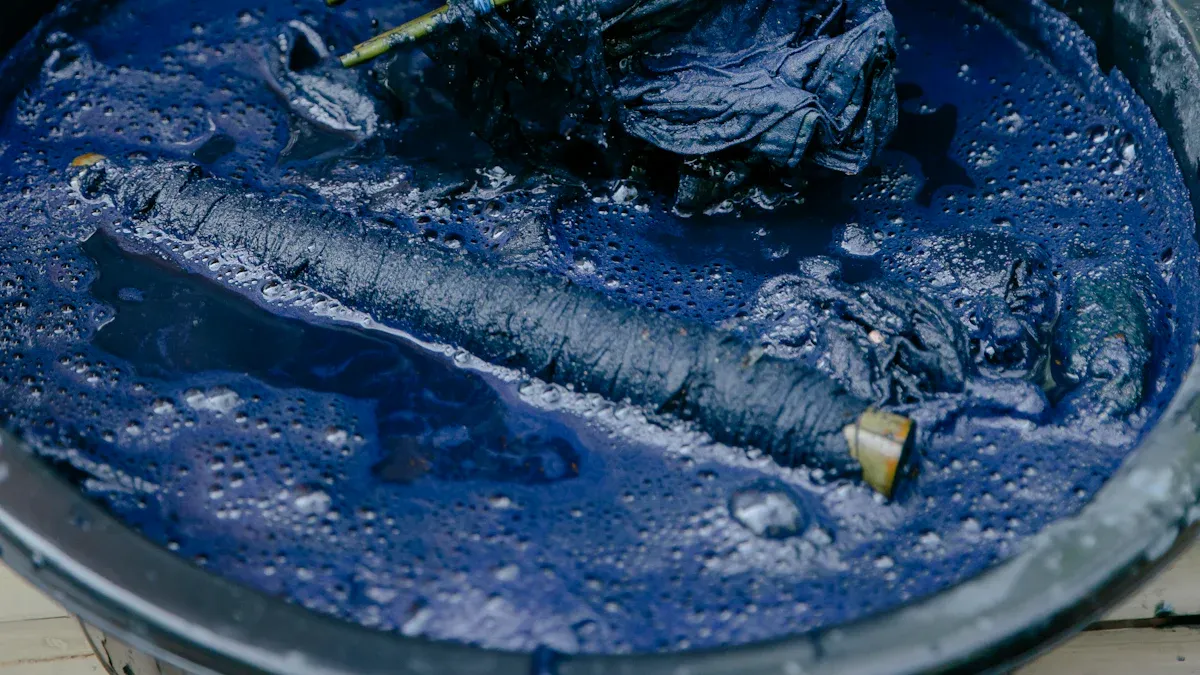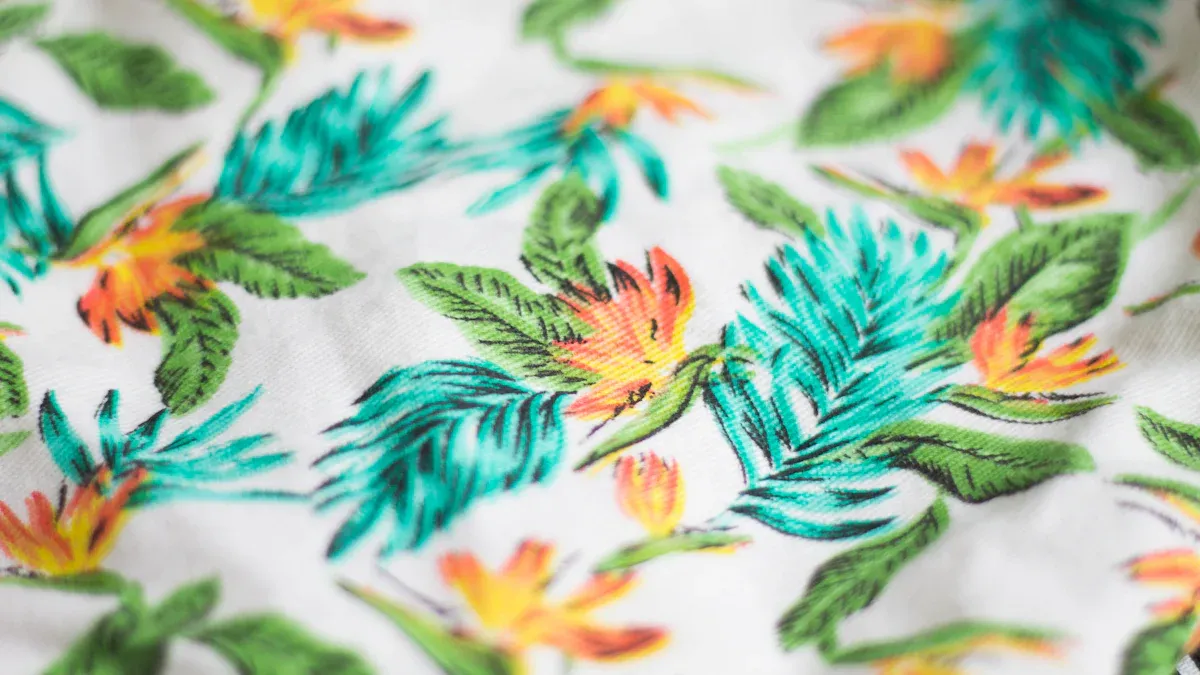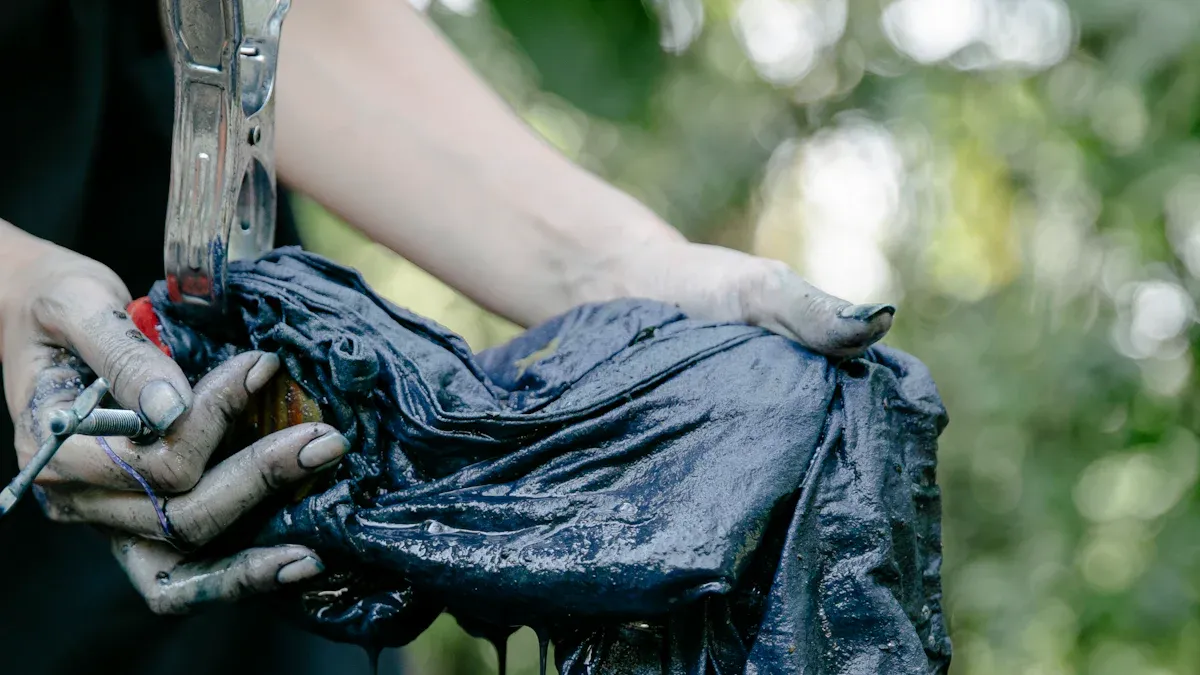
Imagine a world where your fabric choices actively support a cleaner planet. With eco printing fabric, this vision becomes a reality. This groundbreaking approach revolutionizes textile printing by emphasizing sustainability. By utilizing renewable materials and avoiding harmful chemicals, eco printing fabric ensures a safer environment for both you and the Earth. Unlike conventional methods, it significantly minimizes waste at every stage. Choosing products crafted with eco printing fabric means embracing sustainability and safeguarding natural resources for future generations.
Key Takeaways
- Eco printing fabric uses natural colors and renewable materials. It is a better choice that cuts down waste and pollution.
- This process avoids harmful chemicals, making it safer for nature and workers.
- Eco printing uses much less water and energy, helping the planet.
- Picking eco-printed items gives you unique designs that last longer. It adds both style and eco-friendliness to your clothes.
- By choosing eco-friendly fabrics, you help protect Earth and support green living.
What is Eco Printing Fabric?

The Process of Eco-Printing
Eco-printing is a revolutionary approach to sustainable textile printing. It uses natural pigments extracted from plants, flowers, and leaves to create intricate designs directly on fabric. Unlike traditional methods, eco-print avoids synthetic dyes and harmful chemicals. You’ll find this process relies on techniques like botanical printing, where plant materials are pressed onto fabric and steamed to transfer their natural colors and patterns. This method not only produces stunning visuals but also reduces waste and pollution. If you’ve ever wondered how to do eco-friendly printing on fabric, eco-printing offers a simple yet impactful solution that aligns with sustainable design practices.
Natural Materials in Eco-Friendly Textile Printing
Eco-friendly textile printing thrives on the use of renewable and biodegradable materials. Natural fabrics like cotton, wool, and bamboo serve as the perfect base for eco-print designs. These fabrics absorb natural pigments effectively, ensuring vibrant and long-lasting prints. Studies highlight the benefits of natural dyeing methods, such as improved color efficiency and antibacterial properties. For example:
- Benli and Bahtiyari demonstrated that enzyme-ultrasound combinations enhance cotton dyeing with natural dyes.
- Raja and Thilagavathi found that wool treated with alkaline protease achieves stronger color depth.
- Zhang and Cai noted that protease-treated wool dyed with sappan showed better color strength.
These innovations in eco-friendly textile printing prove that natural materials not only elevate aesthetics but also contribute to environmental sustainability.
Sustainable Properties of Eco Printing Fabric
Eco printing fabric stands out for its remarkable sustainability. Compared to traditional methods, it consumes less water, minimizes energy use, and eliminates chemical pollution. The following table illustrates the differences:
| Aspect | Traditional Fabrics | Eco Printing Fabrics |
|---|---|---|
| Water Consumption | High, thousands of liters per kg | Significantly reduced, often waterless methods |
| Chemical Pollution | Releases hazardous chemicals into water | Uses natural dyes, minimizing toxicity |
| Energy Consumption | High carbon emissions from fossil fuels | Utilizes renewable energy sources |
| Waste Generation | Enormous amounts of waste | Focus on recycling and upcycling |
| Microfiber Pollution | Contributes to microplastic pollution | Minimal, especially with natural fibers |
By choosing eco-friendly printing techniques, you support sustainable textile printing that prioritizes resource conservation and waste reduction. Eco-print fabrics embody the principles of sustainable design practices, making them a smart choice for environmentally conscious consumers.
Environmental Benefits of Eco Printing

Waste Reduction in Sustainable Textile Printing
Eco-printing transforms the way fabrics are produced by drastically reducing waste. Unlike conventional methods that rely on subtractive processes, eco-print uses additive techniques to minimize material loss. This approach ensures that every resource is utilized efficiently, leaving little to no waste behind. For example, botanical printing directly transfers natural pigments onto fabric, eliminating the need for excess dyes or chemicals.
To understand the difference, consider the following comparison:
| Method | Waste Reduction Capability |
|---|---|
| Eco Printing | Significantly reduces waste through additive processes, minimizing material loss and defects. |
| Conventional | Inherently creates waste due to subtractive processes that alter raw materials. |
By choosing eco-friendly textile printing, you actively contribute to a reduced environmental impact. This choice not only supports sustainability but also ensures cleaner production practices that benefit the planet.
Elimination of Harmful Chemicals in Eco-Print
Eco-printing eliminates the use of harmful chemicals, making it safer for both the environment and workers. Traditional textile printing often relies on synthetic dyes and toxic substances that pollute water sources and harm ecosystems. Eco-printing, on the other hand, uses natural dyes derived from plants, flowers, and leaves. These biodegradable pigments ensure that no hazardous residues enter the environment.
Improved worker safety is another key benefit. Without exposure to toxic chemicals, workers experience healthier working conditions. This shift toward safer practices aligns with the principles of eco-friendly textile printing, offering a cleaner and more ethical production process. When you choose eco-print products, you support industries that prioritize sustainability and human well-being.
Conservation of Resources Through Renewable Materials
Eco-printing fabric emphasizes the use of renewable materials, conserving valuable resources like water and energy. Natural fibers such as bamboo, cotton, and wool serve as the foundation for eco-friendly textile printing. These materials absorb natural dyes efficiently, reducing the need for excessive water usage during production.
Additionally, eco-printing techniques often utilize renewable energy sources, further lowering the carbon footprint. By opting for eco-print fabrics, you help conserve resources while supporting sustainable practices. Botanical printing, for instance, showcases how renewable materials can create stunning designs without compromising the environment. This innovative approach ensures that every step of the process contributes to a reduced environmental impact.
Comparing Eco Printing to Traditional Methods
Waste Generation in Conventional Textile Printing
Conventional textile printing methods generate an alarming amount of waste. These processes often involve subtractive techniques, where excess dyes, chemicals, and water are discarded after use. This waste not only pollutes the environment but also contributes to the growing problem of textile waste in landfills. According to reports from the Environmental Protection Agency (EPA), while there is limited data specifically on waste from textile printing, the broader issue of textile waste is significant. This highlights the urgent need for sustainable alternatives.
Eco-printing, on the other hand, minimizes waste by using additive techniques. Instead of discarding excess materials, it focuses on directly transferring natural pigments onto fabrics. This approach ensures that every resource is utilized efficiently, leaving little to no waste behind. By choosing eco-friendly textile printing, you actively reduce the environmental burden caused by traditional methods.
Environmental Impact of Traditional Printing Methods
The harmful effects of traditional textile printing extend far beyond waste generation. These methods rely heavily on synthetic dyes and toxic chemicals, which often end up in water sources. This contamination harms aquatic ecosystems and poses risks to human health. Additionally, conventional printing consumes vast amounts of water and energy, leading to high carbon emissions and resource depletion.
In contrast, eco-printing eliminates these harmful effects. It uses natural dyes derived from renewable sources like plants and flowers, ensuring that no toxic residues enter the environment. Furthermore, eco-friendly textile printing techniques often require less water and energy, significantly reducing their carbon footprint. By embracing eco-print fabrics, you support a cleaner, healthier planet while rejecting the damaging practices of traditional methods.
Advantages of Eco Printing Fabric Over Conventional Techniques
Eco-printing offers numerous advantages over conventional textile printing. First, it prioritizes sustainability by using renewable materials and reducing waste. This makes it an ideal choice for environmentally conscious consumers like you. Second, it eliminates harmful chemicals, ensuring safer production processes for workers and cleaner products for end users. Third, eco-friendly textile printing techniques often produce unique, vibrant designs that stand out in quality and aesthetic appeal.
Unlike traditional methods, which rely on mass production and synthetic materials, eco-printing celebrates individuality. Each piece is crafted with care, reflecting the natural beauty of its raw materials. This not only enhances the visual appeal of the fabric but also ensures its durability and longevity. When you choose eco-print products, you enjoy the advantages of eco-friendly textile printing while making a positive impact on the environment.
🌱 Tip: Opt for eco-print fabrics to combine style, sustainability, and quality in your wardrobe or home decor. Every choice you make contributes to a greener future.
Practical Applications and Consumer Benefits
Examples of Eco-Printed Products (e.g., Suerte)
Eco-printed products are transforming the textile industry with their sustainability and unique appeal. Companies like Suerte Textile lead the way by offering a diverse range of eco-printed fabrics. Their advanced production infrastructure supports high-volume manufacturing while maintaining exceptional quality. Suerte specializes in eco-friendly textiles such as bamboo knit, rayon blends, and jacquard fabrics. These materials absorb natural pigments beautifully, creating vibrant designs through techniques like botanical printing.
The growing demand for eco-printed products reflects a shift in consumer values. Studies show a 71% increase in global searches for sustainable goods over the past five years. Millennials, in particular, prioritize sustainability, with 75% considering it in their purchasing decisions. By choosing eco-printed products, you align with brands that share your commitment to environmental responsibility.
Durability and Longevity of Eco-Friendly Textile Printing
Eco-friendly textile printing delivers durability that rivals traditional methods. Sustainable fabrics undergo rigorous testing to ensure long-lasting performance. For example, color fastness to washing improves significantly, with eco-printed fabrics achieving scores of 4 to 4/5 after multiple washes. Light fastness also reaches excellent levels, maintaining vibrant colors even after prolonged exposure.
These advancements make eco-printed textiles ideal for everyday use. Whether you’re selecting clothing or home decor, you can trust these fabrics to retain their quality over time. Suerte’s eco-printed products combine durability with sustainability, offering you a practical and eco-conscious choice.
Aesthetic Appeal and Unique Designs in Eco-Print
Eco-printing celebrates individuality through its artistic approach. Techniques like botanical printing transfer natural pigments directly onto fabric, creating intricate patterns inspired by nature. Each design is unique, reflecting the beauty of the materials used.
Eco-printed fabrics stand out for their vibrant colors and detailed textures. Unlike mass-produced textiles, these products offer a personal touch that enhances their aesthetic appeal. Suerte’s expertise in fabric customization ensures that every piece meets your specific needs, from pattern design to production optimization. By choosing eco-printed textiles, you enjoy stunning visuals while supporting sustainable practices.
🌿 Note: Eco-printed products combine style, durability, and sustainability, making them a smart choice for your wardrobe or home decor.
Eco printing fabric transforms textile production into a sustainable practice that benefits the environment and your lifestyle. It reduces waste, eliminates harmful chemicals, and conserves resources, making it a smarter choice for eco-conscious consumers like you.
By choosing eco-printed products, you actively support a cleaner planet while enjoying fabrics that are durable, visually stunning, and crafted with care.
🌍 Take Action: Make a difference today by opting for eco-friendly textiles. Every purchase helps protect the Earth and promotes sustainable living.
FAQ
What makes eco printing fabric an environmentally conscious alternative?
Eco printing fabric uses natural dyes and renewable materials, reducing waste and pollution. It eliminates harmful chemicals and conserves resources, making it a sustainable choice for you and the planet.
Can eco-printed fabrics match the durability of traditional textiles?
Yes, eco-printed fabrics are highly durable. They undergo rigorous testing to ensure long-lasting quality. You can trust these textiles to maintain their vibrant colors and strength even after repeated use.
Are eco-printed products more expensive than traditional ones?
Eco-printed products may have a slightly higher upfront cost. However, their durability and sustainability make them a cost-effective choice in the long run. You invest in quality while supporting eco-friendly practices.
How do I care for eco-printed fabrics?
Wash eco-printed fabrics in cold water with mild detergent. Avoid harsh chemicals or bleach. Air drying is recommended to preserve their vibrant colors and extend their lifespan.
Where can I find eco-printed products?
You can explore eco-printed products from brands like Suerte Textile. They offer a wide range of high-quality, sustainable fabrics tailored to your needs.



